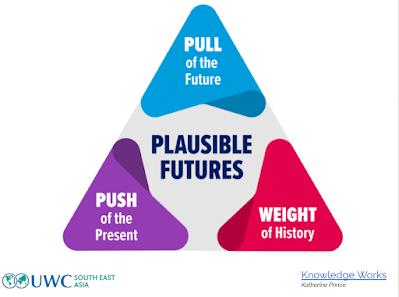As we head into our 50th Anniversary year, there is much to look back to, and to celebrate. Looking back gives us a way to understand why we are where we are today, and how we have become who we are; and knowing who we are today inevitably leads us to ask what's next?
There might have been a time when such a question was not inevitable; when a generation's greatest aspiration might have been to do as the previous generation did - some scholars have suggested that's what much of human history looked like. It is certainly not our lot; today innovation is a given, and we have been innovating for 50 years. But we've come to realise that talking about innovation can be tricky - not just because it's hard to do, but also because the word itself can mean very different things to different people.
Since we opened all those years ago, we have moved from a secondary school of some 1000 students to a K-12 school, across two campuses, now serving around 5600 students. That's necessitated a great deal of very visible innovation; but there has been a great deal of far less visible, but actually far more profound innovation, as I have written about here. So it’s less a case of do we innovate, and more of how far, how fast do we want to innovate, and in what aspects of what we do? Of course recently Covid-19 has pushed us and we did innovate very rapidly indeed – moving online in a few days - but with some undesirable consequences as well as triumphs. I think we were all glad to be back in school, despite the success of remote learning, but we learnt that if we ask "do we value face-to-face learning or remote learning?" then the answer cannot be one or the other - it has to be both.

This is hardly a new idea - as parents we need provide both unconditional love and firm discipline. Neither alone is sufficient, and our focus has to move from one to other as necessary - it's hard to be too precise about that; the best we can do is to be aware of the need for both - and the dangers if we stick with only one for too long.
Once named like this - polarities are situations to manage, not problems to solve, we can start to see they arise very frequently indeed, in personal and professional situations.
In each of these cases, it's easy to see that while we might have to focus on one aspect of each pair at any given time it would be foolish to forget about the other element. As far as innovation goes it seems to me that we've often identified the incorrect pair; we tend to think of innovation as paired with stasis or stagnation - but as I said I don't think innovation is really an option these days; the only question is the pace and extent of the innovation. The real focus should be between disruptive innovation and incremental innovation, to put it in current business parlance. We need both; and we need to be deliberate about how we approach this as we head into our second half century.
As we think about this polarity we need to look at the benefits of each side but also not be blind to the downsides of an exclusive focus on any one side. Framing the situation like this is a good step in the first direction.
What's likely to come out of this thinking? Well, this isn't the place for any announcement, but one thing we can say is that we should here be only talking about means and not ends. Our UWCSEA Mission to make education a force for a peaceful and sustainable future remains unchanged; the question is how to deliver that Mission with greater power. So there is a fixed point, an agreed destination; and the challenges and opportunities are more to do with the VUCA world we live in. What we are finding is that there are no simple paths from A and B; things look more like the topographical map below, where the black line is naive, and with the added caveat that the mountains are being eroded and uplifted as we speak, uplifted here, with the rivers flooding and even the occasional covid volcano going off (we have not yet been hit by an asteroid). Under such a topography, there is a real question over the validity of long-term fixed plans. What we have to know is that we need to head in particular direction, and that it won’t be a straight line.
That's going to make for an exciting 50 years ahead. Watch this space.




Given what I am trying to navigate at this very hour - this post came as a wonderful enabler towards decision making - thank you!
ReplyDeleteGood grief Aman, how do you have time to read this today!!
Delete